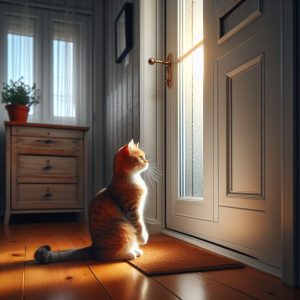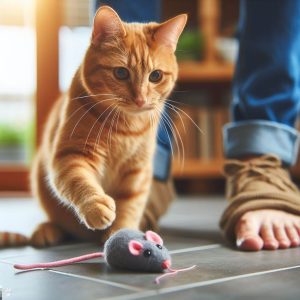Have you noticed your cat walking around with big, dilated pupils on a regular basis? As a cat owner, enlarged pupils may signal a potential problem.
Cats’ pupils work similarly to humans—the pupils constrict and dilate to regulate the amount of light entering the eyes. In bright conditions, the pupils become narrow slits to avoid overstimulation. In darkness, the pupils dilate to allow more light in so the cat can see better.
But sometimes, a cat’s pupils remain excessively dilated even in bright light when they should be constricted. Persistently enlarged pupils often indicate:
- Illness
- Stress or anxiety
- A neurological condition
- Eye abnormalities
If your cat’s pupils stay big for no apparent reason, don’t ignore it. Dilation accompanied by other symptoms warrants a veterinary visit to pinpoint the underlying cause.
Read on to understand why your cat has chronically dilated pupils and how to address it.
What Causes Frequent Pupil Dilation in Cats?
Many factors can trigger a cat’s pupils to remain dilated, ranging from normal responses to serious medical issues. Here are some of the most common reasons behind perpetual pupil enlargement:
1. Stress or Anxiety
Cats experiencing stress or anxiety frequently exhibit dilated pupils along with other behavioral changes. Exposure to unfamiliar environments or loud noises can spark the dilation. Even subtle home changes you introduce can stress some cats out.
Cats also dilate their pupils when frightened or overstimulated. It’s an instinctual reaction triggered by the “fight or flight” response. In the wild, enlarging the pupils allows more light in to identify threats and escape danger.
If you notice pupil dilation plus signs like:
- Hiding more often
- Aggression or irritability
- Excessive vocalization
- Loss of appetite
- Avoiding affection
Stress may be the culprit. Try to identify and minimize environmental stressors to soothe your anxious cat.
2. Pain or Illness
Feline pupils often dilate as a response to pain or systemic illness.
When sick, the pupils enlarge to allow the maximum amount of light in. This light aids visual recognition of dangers like predators when the cat is vulnerable.
Underlying painful conditions like dental disease, arthritis, pancreatitis or even severe constipation can all cause pupils to remain dilated.
Cats also commonly have dilated pupils with upper respiratory infections (URIs) or high fevers. The pupils enlarge due to sinus pressure and congestion associated with URIs.
And with fevers, dilation occurs because the pupils’ responsiveness gets thrown off by the elevated body temperature.
3. Medications
Certain medications provoke pupil dilation as a side effect. Medicines derived from adrenaline-like chemicals tend to stimulate dilation.
Some examples include:
- Bronchodilators used for asthma
- Sympathomimetic agents like phenylephrine for congestion
- Antidepressants such as amitriptyline
- Anticonvulsants like gabapentin for seizures
Usually the dilation resolves once the medication is stopped. But cats on chronic medications may experience persistent enlarged pupils.
4. Eye Problems
Cats can develop vision problems that damage the eyes and impair the pupils’ ability to react normally to light. Common examples include:
Glaucoma
With glaucoma, pressure builds up inside the eye, potentially causing blindness. The pupils remain dilated due to the high intraocular pressure. Excess pressure also leads to a bluish hue in the cornea called buphthalmia.
Blindness
Blind cats often move around with dilated pupils to maximize low light intake. The pupils fail to constrict simply because the retina’s light receptors are no longer functional. Older cats are prone to developing blindness from progressive retinal atrophy.
Uveitis
This condition involves painful inflammation of the uvea, or middle layer of the eye. The inflamed eye waters excessively. And light sensitivity leads to dilated pupils.
Horner’s Syndrome
A condition affecting the nerves that control pupil constriction. It leads to one pupil staying dilated larger than the other. It can result from middle/inner ear infections, nerve trauma, or even stroke.
If your cat’s eyes appear cloudy, red, painful or have discharge, see the vet promptly. Eye issues are frequently treatable if caught early.
5. Hypertension
High blood pressure, or hypertension, often causes pupils to remain dilated.
Cats usually develop hypertension secondary to other conditions like:
- Chronic kidney disease
- Hyperthyroidism
- Diabetes
- Heart disease
- Cancer
The elevated blood pressure puts abnormal pressure on the eye. This impairs the muscles controlling pupil size.
6. Hyperthyroidism
An overactive thyroid gland leads to excess production of thyroid hormones. The hormones overstimulate body functions like heart rate and metabolism.
Many hyperthyroid cats have persistently dilated pupils along with symptoms like weight loss, increased appetite, vomiting and hyperactivity.
7. Neurological Disorders
Dilation can stem from certain neurological conditions impacting normal nerve signaling to the pupils.
Examples include:
- Brain tumors
- Thiamine deficiency
- Nerve trauma
- Stroke
- Encephalitis
- Meningitis
Neurological issues lead to many other symptoms too – like tremors, seizures, difficulty balancing, and behavior changes.
How to Tell if Your Cat’s Pupil Dilation Isn’t Normal
Not all pupil dilation is problematic. It’s important to distinguish normal, responsive dilation from perpetual dilation indicating disease.
Here’s how to tell:
Does the size change? Healthy cats’ pupils will constrict in bright light and dilate in darkness appropriately. Illness prevents this natural response.
When does it happen? Transient dilation when startled or overstimulated is normal. But chronic, unprovoked dilation is abnormal.
What’s the severity? Measure the pupil size in dim and bright light. Subtle differences are less concerning than pupils staying hugely dilated in all conditions.
Do other symptoms occur? Dilation combined with lethargy, vocalizing, or appetite changes points to medical issues. Isolated dilation warrants monitoring, but may resolve on its own.
Are the eyes normal? Redness, cloudiness, excessive tearing or visible third eyelid could indicate eye damage or disease.
Is the cat stressed? If environmental stressors or anxiety triggers are present along with dilated pupils, address these factors first.
Monitor pupil changes over several days. Acute dilation may resolve on its own. But cats with pupils chronically fixed in a dilated state need veterinary attention to diagnose the root cause.
What Does it Mean if One Pupil is Dilated More Than the Other?
Asymmetry between the two eyes is always abnormal. The scientific term is anisocoria.
Uneven pupil dilation has several potential causes:
- Injury or trauma to the eye or surrounding muscles/nerves
- Glaucoma or uveitis affecting one eye
- Horner’s syndrome, which impairs pupil nerve signaling
- Eye medication drops only applied to one eye
- Tumors or lesions affecting pupil nerves on one side
- Stroke, which can damage pupil nerves
Anisocoria indicates substantial eye or nerve damage. Seek prompt veterinary assessment to protect your cat’s vision and comfort.
How is the Cause of Dilated Pupils Diagnosed?
Your veterinarian will perform a full physical exam and thorough eye evaluation to pinpoint why your cat’s pupils remain dilated.
Initial testing your vet may conduct includes:
- Ophthalmoscopy – Examining the eye’s structures with an instrument called an ophthalmoscope. This allows assessment of the lens, retina, and optic nerve for abnormalities.
- Tonometry – Measuring the pressure inside each eye using a tonometer. This helps diagnose glaucoma.
- Fluorescein staining – Putting fluorescent dye on the eye to reveal scratches, ulcers or other damage when viewed under a UV light.
- Neurological evaluation – Testing reflexes, balance, and muscle tone to detect neurological disorders.
Your vet will also review your cat’s full medical history and any medications being given.
Based on initial findings, your vet may recommend:
- Blood work – To identify issues like kidney failure, diabetes, cancer or hyperthyroidism
- Urinalysis – Helps diagnose urinary tract infections, kidney disorders, and diabetes
- Radiographs or ultrasound – Imaging tests to visualize eye structures and examine other organs
- Biopsy – Taking a tissue sample if cancer is suspected
With treatment of the underlying disease, the pupils should regain normal function.
What is the Treatment for Dilated Pupils in Cats?
The appropriate treatment depends on the specific cause of your cat’s dilated pupils.
For anxiety or stress:
- Minimize alarming noises, visitors, and other environmental stressors
- Diffuse calming feline pheromones using Feliway plugins
- Consider anti-anxiety medications short-term if needed
For pain:
- Administer pain medications prescribed by your veterinarian
- Address the source of pain – like dental issues, arthritis or injuries
For eye problems like glaucoma:
- Prescribe medicated eye drops to decrease pressure and fight inflammation
- Perform eye surgery for severe glaucoma or uveitis
- Remove cataracts obstructing vision
For hypertension:
- Prescribe blood pressure medications like amlodipine to decrease pressure
- Treat underlying condition causing hypertension
For hyperthyroidism:
- Give methimazole daily to block excess thyroid hormone production
- Use radioactive iodine therapy to destroy overactive thyroid cells
- Surgically remove enlarged thyroid nodules
For neurological conditions:
- Address seizures with phenobarbital or levetiracetam
- Give steroids to reduce brain inflammation
- Surgically remove operable tumors or cysts
- Physical therapy to improve balance and strength
In all cases, follow up regularly to ensure treatment efficacy. Monitor pupils and other symptoms.
Though dilated pupils are usually a negative sign, prompt diagnosis and treatment alleviates discomfort. With the underlying disorder properly controlled, most cats regain normal pupillary function.
At-Home Care for Cats with Dilated Pupils
While working with your vet to control the root problem, you can take steps at home to soothe your dilated-pupil cat:
Provide a quiet, peaceful environment
Minimize loud noises, visitors, and rambunctious pets that may further stress your cat out. Offer access to isolated, quiet hiding spots.
Limit light exposure
Draw blinds and curtains to create dark spaces. Dim bright overhead lights. Excessive light is uncomfortable for dilated pupils. But avoid total darkness which can spur further dilation.
Apply lubricant eye drops
Discuss non-prescription eye drops to provide moisture and relieve dryness. But avoid medicated drops not prescribed by your vet.
Gently wipe away eye discharge
Use a soft, damp cloth to gently clean crusty discharge that can build up with certain eye conditions. Carefully avoid pressure on the eyeball.
Monitor appetite and litter box habits
Log any changes like decreased eating, weight loss, increased urination or defecation accidents that could indicate illness progression.
Keep stress levels low
Continue normal grooming, playtime and affection. Cater to your cat’s preferences. Consistency and predictability minimize anxiety.
Follow veterinary recommendations
Give all prescribed medications as directed. Return for follow up exams to monitor eye health. Call your vet if you have any concerns.
With diligence and proactive treatment, most cats with dilated pupils recover well and avoid permanent vision damage. Stay vigilant for changes and partner closely with your veterinarian.
How to Constrict a Cat’s Pupils
Sometimes cats experience discomfort from enlarged pupils. Certain emergency eye drops can provide temporary relief by constricting dilated pupils.
But avoid using any eye drops without your veterinarian’s guidance. Many popular human eye drops for redness like Visine and ClearEyes are extremely dangerous and toxic to cats when ingested.
Safe options for temporary pupil constriction include:
Pilocarpine
This eye drop is commonly used to treat glaucoma. It constricts the pupils and decreases pressure inside the eye. Generally prescribed twice daily.
Neosynephrine
Derived from adrenaline, this drop also shrinks the pupils. It’s typically applied 1-3 times daily but works quickly.
Atropine
Atropine has the opposite effect – it dilates pupils. But this drop may help break abnormal spasms causing dilation. Potentially prescribed 1-2 times a day.
Discuss these medicated drops with your veterinarian before using. Avoid over the counter products. And never give human drops like Visine.
Are Dilated Pupils Dangerous? When to See the Veterinarian
Pupils enlarged at inappropriate times usually signify:
- Discomfort
- Eye strain
- Increased light sensitivity
- Vision impairment
While not immediately life-threatening, chronic dilation requires investigation. Let your vet examine your cat sooner rather than later.
Promptly contact the vet if you notice:
- Uneven pupils
- Extremely large pupils
- Cloudiness, redness, discharge or bulging eyes
- Squinting, pawing at the eyes, or crusty buildup
- Changes in behavior like aggression or hiding
- Appetite changes, lethargy, or vocalizing
The underlying cause likely won’t resolve without treatment. Dilated pupils plus other clinical signs warrant urgent vet care to protect your cat’s health and comfort.
Why Are My Cat’s Pupils Big? Key Takeaways:
- Persistently dilated pupils often signal underlying illness, anxiety or eye issues.
- Have your vet examine your cat to pinpoint the root cause and rule out serious conditions.
- Treatments range from anti-anxiety meds and eye drops to blood pressure control and thyroid medication.
- Addressing the underlying disorder restores normal pupil function in most cats.
- Provide ample TLC, monitor symptoms, and follow veterinary recommendations.
- Prompt diagnosis and treatment helps ensures the best outcome for your cat’s vision and quality of life.
If your cat’s eyes remain continuously dilated, don’t delay. Consult your trusted veterinarian right away. With the right care and stress reduction, your feline’s pupils should regain their normal responsiveness and size.



